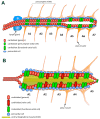Genome-Wide Approaches to Drosophila Heart Development
- PMID: 27294102
- PMCID: PMC4902288
- DOI: 10.3390/jcdd3020020
Genome-Wide Approaches to Drosophila Heart Development
Abstract
The development of the dorsal vessel in Drosophila is one of the first systems in which key mechanisms regulating cardiogenesis have been defined in great detail at the genetic and molecular level. Due to evolutionary conservation, these findings have also provided major inputs into studies of cardiogenesis in vertebrates. Many of the major components that control Drosophila cardiogenesis were discovered based on candidate gene approaches and their functions were defined by employing the outstanding genetic tools and molecular techniques available in this system. More recently, approaches have been taken that aim to interrogate the entire genome in order to identify novel components and describe genomic features that are pertinent to the regulation of heart development. Apart from classical forward genetic screens, the availability of the thoroughly annotated Drosophila genome sequence made new genome-wide approaches possible, which include the generation of massive numbers of RNA interference (RNAi) reagents that were used in forward genetic screens, as well as studies of the transcriptomes and proteomes of the developing heart under normal and experimentally manipulated conditions. Moreover, genome-wide chromatin immunoprecipitation experiments have been performed with the aim to define the full set of genomic binding sites of the major cardiogenic transcription factors, their relevant target genes, and a more complete picture of the regulatory network that drives cardiogenesis. This review will give an overview on these genome-wide approaches to Drosophila heart development and on computational analyses of the obtained information that ultimately aim to provide a description of this process at the systems level.
Keywords: ChIP-chip; ChIP-seq; cardiogenesis; cardiogenic transcription factors; genetic screens; genomics; heart development; machine learning; transcriptomics.
Conflict of interest statement
The author declares no conflict of interest.
Figures


Similar articles
-
Genetic and genomic dissection of cardiogenesis in the Drosophila model.Pediatr Cardiol. 2010 Apr;31(3):325-34. doi: 10.1007/s00246-009-9612-1. Epub 2009 Dec 25. Pediatr Cardiol. 2010. PMID: 20033682 Review.
-
Genome Wide Approaches to Identify Protein-DNA Interactions.Curr Med Chem. 2019;26(42):7641-7654. doi: 10.2174/0929867325666180530115711. Curr Med Chem. 2019. PMID: 29848263 Review.
-
Genes and networks regulating cardiac development and function in flies: genetic and functional genomic approaches.Brief Funct Genomics. 2012 Sep;11(5):366-74. doi: 10.1093/bfgp/els028. Epub 2012 Aug 20. Brief Funct Genomics. 2012. PMID: 22908209 Review.
-
Cellular Mechanisms of Drosophila Heart Morphogenesis.J Cardiovasc Dev Dis. 2015 Mar 1;2(1):2-16. doi: 10.3390/jcdd2010002. J Cardiovasc Dev Dis. 2015. PMID: 26236710 Free PMC article.
-
A Guide to Genome-Wide In Vivo RNAi Applications in Drosophila.Methods Mol Biol. 2016;1478:117-143. doi: 10.1007/978-1-4939-6371-3_6. Methods Mol Biol. 2016. PMID: 27730578 Review.
Cited by
-
Model system identification of novel congenital heart disease gene candidates: focus on RPL13.Hum Mol Genet. 2019 Dec 1;28(23):3954-3969. doi: 10.1093/hmg/ddz213. Hum Mol Genet. 2019. PMID: 31625562 Free PMC article.
-
Drosophila Heart as a Model for Cardiac Development and Diseases.Cells. 2021 Nov 8;10(11):3078. doi: 10.3390/cells10113078. Cells. 2021. PMID: 34831301 Free PMC article. Review.
-
From promoter motif to cardiac function: a single DPE motif affects transcription regulation and organ function in vivo.Development. 2024 Jul 15;151(14):dev202355. doi: 10.1242/dev.202355. Epub 2024 Jul 29. Development. 2024. PMID: 38958007 Free PMC article.
-
Age-dependent diastolic heart failure in an in vivo Drosophila model.Elife. 2017 Mar 22;6:e20851. doi: 10.7554/eLife.20851. Elife. 2017. PMID: 28328397 Free PMC article.
-
Conserved signaling mechanisms in Drosophila heart development.Dev Dyn. 2017 Sep;246(9):641-656. doi: 10.1002/dvdy.24530. Epub 2017 Jul 12. Dev Dyn. 2017. PMID: 28598558 Free PMC article. Review.
References
-
- Bodmer R., Frasch M. Development and Aging of the Drosophila Heart. In: Harvey R.P., Rosenthal N., editors. Heart Development and Regeneration. Volume 1. Heart Development and Regeneration; Academic Press Oxford, UK: 2010. pp. 47–86.
-
- Cook R.K., Christensen S.J., Deal J.A., Coburn R.A., Deal M.E., Gresens J.M., Kaufman T.C., Cook K.R. The generation of chromosomal deletions to provide extensive coverage and subdivision of the Drosophila melanogaster genome. Genome Biol. 2012;13:R21. doi: 10.1186/gb-2012-13-3-r21. - DOI - PMC - PubMed
Grants and funding
LinkOut - more resources
Full Text Sources
Other Literature Sources
Molecular Biology Databases

